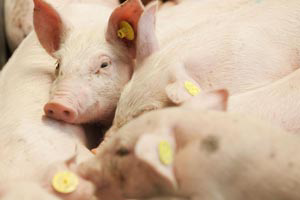Blog: Ranking of antimicrobials in pig production

The European Commission (EC) has asked the European Medicines Agency (EMA) to look at ranking of antibiotics in veterinary medicine and this is still under discussion. The British Pig Veterinary Society (PVS) has come out with their own ranking, to support the responsible use of antibacterials in pig medicine.
(See Table 1) Class 1 antibacterials are to be used as a standard, within responsible use guidelines “as little as possible but as much as necessary.” These antimicrobials are considered to have least impact on human medicine. The Class 2 antimicrobials should not be used unless sensitivity testing and/or clinical experience has proven that Class 1 antimicrobials are not effective or available, within the terms of the SPC (Summary of Product Characteristics), the document that specifies how the drugs should be used. Class 3 compounds are considered the “last resort” antimicrobials, which may be of concern regarding human use antimicrobial drugs and therefore should only be used when no other options are available and supported by sensitivity testing. Possibly, they should not be used for prevention.
Colistin is one antibiotic, which is widely used in pig medicine but has recently become of interest and value in human medicine as a treatment of last resort against Gram-negative bacteria, in spite of its toxicity when administered systemically. The situation will be monitored in the future. One particular alternative is the use of zinc oxide in weaner diets to prevent post-weaning diarrhoea, and this will help reduce the use of colistin but some Member States still do not permit it.
There has been a recent extension to a Class 2 compound, amoxicillin, by the addition of clavulanic acid. This has been introduced to combat amoxicillin resistance in Escherichia coli and Actinobacillus pleuropneumoniae, particularly. The product (Strenzen – Novartis) is now available as a soluble for use in drinking water and accompanies an existing injectable product Synulox (Zoetis). The clavulanic acid binds to the enzyme (beta-lactamase) that is produced by the resistant bacteria, which destroys the amoxicillin. Clavulanic acid is also effective against some of the extended spectrum beta-lactamases (ESBLs), which have been associated with 3rd and 4th generation cephalosporin use, so should be helpful in combating a number of resistance problems, making amoxicillin work again. This is another example of filling in the gaps in the veterinary therapeutic armoury, rather than development and introduction of brand new antimicrobials, something else the EC/EMA is looking at. They are also considering whether new families of antimicrobials should only be used in human medicine.
Whilst filling in the responses to these questions, it became clear that we needed to inform/remind the authorities that the use of the very advanced antibiotics used in human medicine, such as tigecycline and the carbapenems, are unlikely to be used in farm-animal medicine, as there are no MRLs (maximum residue limits) set for edible tissues. Currently, this would be ‘illegal use’ in the EU to give such products to meat-producing animals like the pig and if found, would cause all the carcasses to be condemned and a likely punishment to the farmer. In companion animals (dogs and cats) and to a lesser extent valuable horses, not for human consumption, a wider range of antibiotics available in man may be used under the ‘cascade’, if no suitable alternative is approved for use in these animals. This use is specifically for complicated therapeutic cases and not on a routine basis so usage would be relatively minor.
It is likely that the new legislation proposals will be released after the European elections this summer, so I think PVS has been brave and proactive to come out with their recommendations prior to these proposals. Hopefully, responsible use will win the day, so that veterinarians can treat the animals effectively under their care.
(Photo: Bart Nijs. Copyright: Reed Business)











